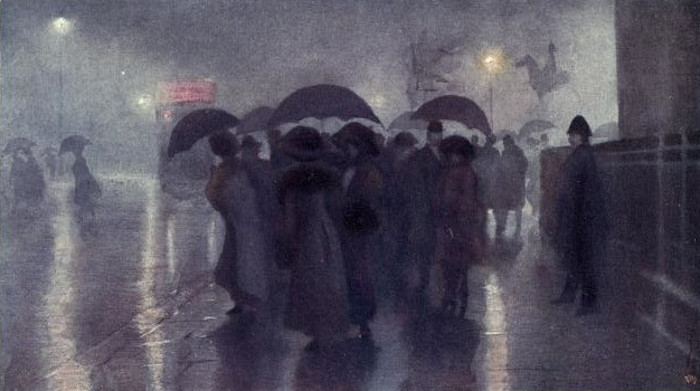
This image turned up in the subreddit Confusing Perspectives back in February.
One user wrote, “Someone needs to make this into real sheet music and see how it sounds. I’m curious now.”
Another version:
https://www.youtube.com/watch?v=MT5erpy3kOA

This image turned up in the subreddit Confusing Perspectives back in February.
One user wrote, “Someone needs to make this into real sheet music and see how it sounds. I’m curious now.”
Another version:
https://www.youtube.com/watch?v=MT5erpy3kOA

Only a few years back those who carried Umbrellas were held to be legitimate butts. They were old fogies, careful of their health, and so on; but now-a-days we are wiser. Everybody has his Umbrella. It is both cheaper and better made than of old; who, then, so poor he cannot afford one? To see a man going out in the rain umbrella-less excites as much mirth as ever did the sight of those who first — wiser than their generation — availed themselves of this now universal shelter.
— William Sangster, Umbrellas and Their History, 1855
In 1899 Notes & Queries reprinted an account, now thought to be apocryphal, of “the first silk hat in London”:
It was in evidence that Mr. Hetherington, who is well connected, appeared upon the public highway wearing upon his head what he called a silk hat (which was offered in evidence), a tall structure, having a shiny lustre, and calculated to frighten timid people. As a matter of fact, the officers of the Crown stated that several women fainted at the unusual sight, while children screamed, dogs yelped, and a young son of Cordwainer Thomas, who was returning from a chandler’s shop, was thrown down by the crowd which had collected and had his right arm broken.
Supposedly Hetherington argued that he’d broken no law, and the Times backed him up: “In these days of enlightenment it must be considered an advance in dress reform, and one which is bound, sooner or later, to stamp its character upon the entire community.”

For years, under a “gentleman’s agreement,” the Philadelphia Art Commission would approve no new structure that rose higher than the statue of William Penn atop city hall. Then, in March 1987, it approved One Liberty Place, a steel-and-glass skyscraper that rose 121 meters above Penn’s head.
In the next 22 years no major professional sports team based in Philadelphia won a championship.
Finally, in 2007, during the completion of the 297-meter Comcast Center downtown, workers John Joyce and Dan Ginion attached a small figurine of Penn to its topmost beam. The following year, the Philadelphia Phillies won the World Series.
In 2017 another Penn statuette was placed atop the newly completed 342-meter Comcast Technology Center. “They did not want to take the chance and wait for the jinx,” said the building’s construction manager. A few months later, the Eagles won the Super Bowl.
In “The Adventure of the Empty House,” an old book collector visits John Watson’s house, “his precious volumes, a dozen of them at least, wedged under his right arm.” He says, “Maybe you collect yourself, sir; here’s British Birds, and Catullus, and The Holy War — a bargain every one of them. With five volumes you could just fill that gap on that second shelf.”
Now, this must mean either that two of the titles comprised two volumes apiece or that one comprised three volumes, a point first made by Magistrate S. Tupper Bigelow. But which is it? In the strangely half-specified world that Holmes and Watson inhabit, the fact of the matter seems not to exist.
Philosopher Terence Parsons asks whether Holmes has a mole on his back. Since the stories are silent on this point, it seems that he neither has one nor doesn’t.
See Truth and Fiction.
In 2013, University of Minnesota geography student Daniel Crawford composed “A Song of Our Warming Planet,” a solo cello piece built on climate data. The pitch of each note corresponds to the average annual surface temperature of a year in the range 1880-2012 in data from NASA’s Goddard Institute of Space Studies; each ascending halftone represents roughly 0.03°C in planetary warming.
“Climate scientists have a standard toolbox to communicate their data,” Crawford said. “We’re trying to add another tool to that toolbox, another way to communicate these ideas to people who might get more out of music than maps, graphs, and numbers.”
Below: He later applied the same method to create a string quartet using data from 1880 to 2014. The four parts reflect the average annual temperatures in four regions: the cello the equatorial zone, the viola the mid-latitudes, and the violins the high latitudes and the arctic.
Prove that if seven darts land on a dartboard, there will always be two darts that are no farther apart than the distance of one radius.
In 2014, Italian artist Sven Sachsalber set out literally to find a needle in a haystack.
The performance, undertaken at the Palais de Tokyo in Paris, was allotted two days. Amazingly, Sachsalber found the needle with a few hours to spare.
Now we need a new saying.
When the coal mines of Vulcan, W.Va., gave out in the early 1960s, the only legal route by which to enter and exit the town was a swinging bridge too narrow to accommodate a vehicle. The 200 remaining residents pleaded with the state to repair the bridge, but no action was taken, and in 1975 the bridge collapsed, leaving the residents hemmed in between a river to the west and impassable mountains to the east, reduced to using a hazardous gravel road owned by the Norfolk and Western Railway. Still state officials were reluctant to rebuild the bridge, noting the limited traffic it would carry and the competing priorities in the state.
So the residents of Vulcan wrote to the Soviet embassy in Washington, requesting foreign aid. Soviet journalist Iona Andronov arrived on Dec. 17, 1977, to survey the problem. “He was sincere,” said resident John Robinette. “The Russians said they would keep an eye on the bridge and see if it were built. If not, they would.”
Within an hour the state announced it would do the work, and today a one-lane bridge connects Vulcan to the outside world. “Our government was afraid the Russians would build the bridge,” Robinette said. “They were embarrassed into it, and nothing will convince me otherwise.”
(Thanks, Paul.)

“I do not remember this day.” — Dorothy Wordsworth, diary, March 17, 1798
“Such a beautiful day, that one felt quite confused how to make the most of it, and accordingly frittered it away.” — Caroline Fox, diary, January 4, 1848
“I shall not remember what happened on this day. It is a blank. At the end of my life I may want it, may long to have it. There was a new moon: that I remember. But who came or what I did — all is lost. It’s just a day missed, a day crossing the line.” — Katherine Mansfield, diary, Jan. 28, 1920
“Wrote nothing.” — Franz Kafka, diary, June 1, 1912
“I awakened feeling dull. The weather is neither cheerful nor depressing. It makes me restless. The trees are tossed by gusty, fantastic wind. The sun is hidden. If I put on my dressing-gown I am too hot, if I take it off I am cold. Leaden day in which I shall accomplish nothing worth while. Tired and apathetic brain! I have been drinking tea in the hope that it would carry this mood to a climax and so put an end to it.” — George Sand, diary, June 1, 1837
Samuel Johnson resolved 14 times “to keep a journal.” The first resolution was in 1760, the last in 1782.
Here’s a surprise: A new geoglyph has been found in the soil of the Nazca Desert in southern Peru.
This one, evidently a cat, appears to be the oldest yet — it may have been engraved in the earth as early as 200 B.C. and has been waiting all this time to be discovered.
“The figure was barely visible and was about to disappear because it is situated on quite a steep slope that’s prone to the effects of natural erosion,” the culture ministry wrote.
“It’s quite striking that we’re still finding new figures,” said chief archaeologist Johny Isla, “but we also know that there are more to be found.”